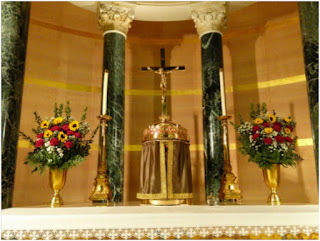NON NISI TE, DOMINE: “Nothing but you Lord”
“You have written well of me, Thomas. What do you want as
your reward?” spoke Jesus from the Crucifix. To which a prayerful St.
Thomas, gave his famous response: “Non nisi te, Domine” -Nothing but you
Lord.
This well-known account, of revealing intimacy and
communication between Our Lord and St. Thomas can offer itself as a prudent
guide when reflecting on the illustrious work and life of St. Thomas Aquinas.
Regardless of the accuracy of the details of this event (as there are slight
variants to the account), the spirit of which it embellishes is quite evident
in any proper reading of the Angelic Doctor. For all that Thomas was and is, in
the corpus of his work, perhaps the greatest exposition of theological
eloquence is his spirit of self-abandonment to Divine Governance. This is not
to separate his expansive insight and generous labor from this spirit of love
as if they were somehow incongruously present within him. Rather, it is to
simply say that St. Thomas Aquinas was a man of great humility, obedience, and
love, three themes which can be viewed in this three-panel (triptych) painting.
Philosophia, is fittingly inscribed upon the name
of Sanctus Thomas de Aquino. For if there was ever a word that can
properly orientate the identity of St. Thomas, it would be this one, which
signifies love of wisdom. The love and pursuit of Wisdom is clearly a
dominant impulse in the work of Aquinas who faithfully pursued truth, not for
its own sake, but for the manner in which it brings man to his proper end,
namely God.
Just above this proclamation of identity, comes the main
partition of this piece, which reveals a habited Aquinas sitting down on a
chair with a rested book on his lap, which serves to indicate received wisdom.
Notably he is also gesturing his hands in a fashion that imitates the act of
instructing. His hands also
communicate part of his work as a philosopher. Aquinas is well known for
explaining the famous five ways to demonstrate the existence of God. That is
why his hands show Aquinas counting his five fingers with his right hand.
Wisdom and Instructing are veraciously united in the
two-fold reality that both properly nourish the other in the pursuit of truth.This
is a principle that endowed itself into the operative humility of St. Thomas.
As he knew very well that, according to right reason, true humility is not
writing or instructing for one’s own glory or self-gratification. Rather, it is
bearing true reverence and glory to God.
Furthermore, the Angelic Doctor is waited on by an angel on
either side of him as they fill the other two panels of this work of art. Their
presence is not merely to serve as a reminder of his impressive doctrine on
these incorporeal creatures or to highlight his angelic purity of virtue that
he had; albeit these are both significant and laudable. Rather the presence of
the angels can also serve to impress further the realization that like angels,
Aquinas spent his work and life, obediently communicating not his own message,
authority, or glory, but that of God.
Although originally located in the apse of the main Chapel,
this work of art is currently located in the John Paul II building in a
conference room that among other things is host to the Seminarian Final
Evaluations which are held at the conclusion of each formation year. It is
quite fitting that the evaluations are spectated by such a great exemplar of
holy self-abandonment to Divine Goodness. Indeed, as tradition proclaims
Christians will have our Final Judgement by the reality and fullness of
this witness.
In the final analysis, by writing and speaking well of the
Truth that he had received, St. Thomas was cooperating with grace and
faithfully responding to his Christian vocation. In many ways this is the same
obligation of charity that the Priest receives upon taking the holy office. The
greatest homily that the Priest will ever give is that of a virtuous life. This
consists in holy self-abandonment and the habitual
witness of “religious submission of the intellect and will” to Divine
Providence.
Let us pray always for the grace to follow the holy example
of St. Thomas Aquinas, that through his intercession, we too may be found
worthy to confidently proclaim with utter sincerity: Non nisi te, Domine.
Written by Joe Luis Hernandez, Seminarian for the Diocese of Brownsville





Comments
Post a Comment